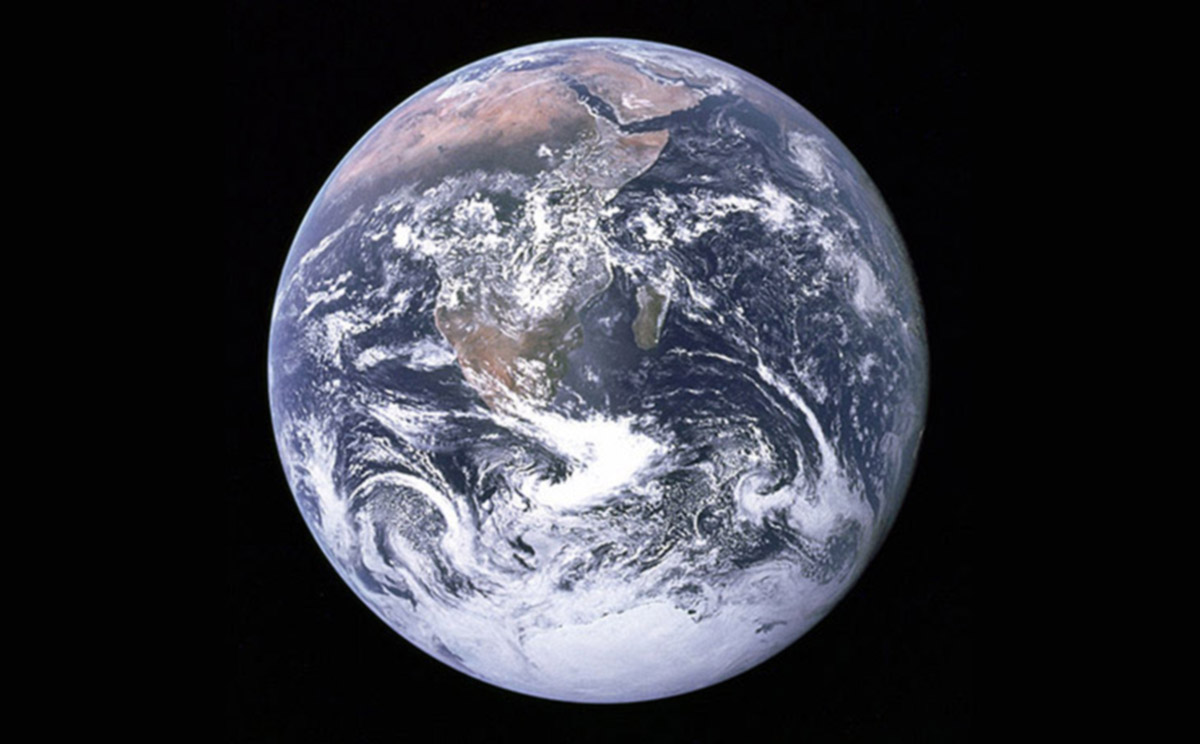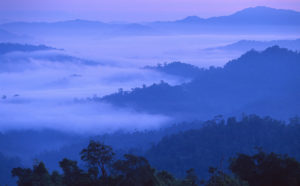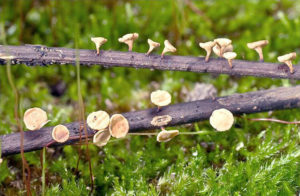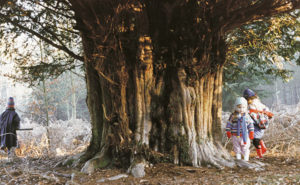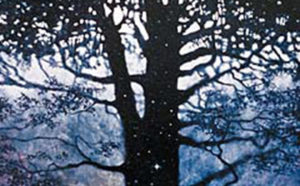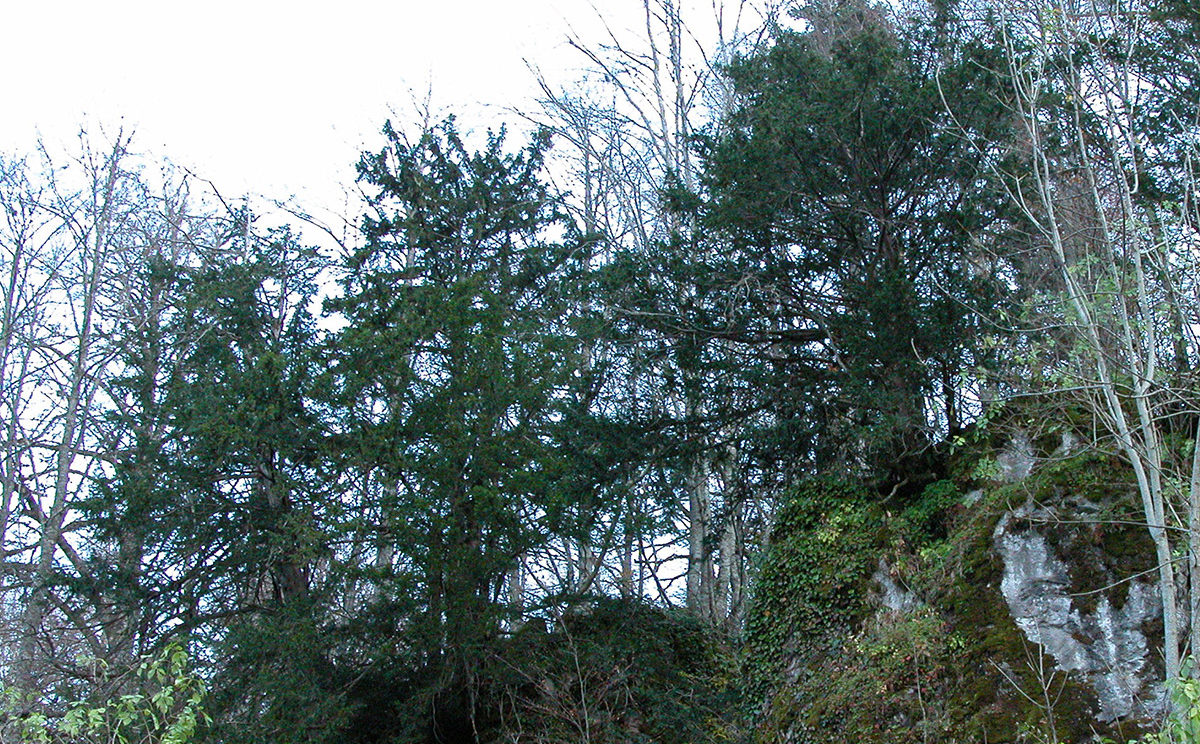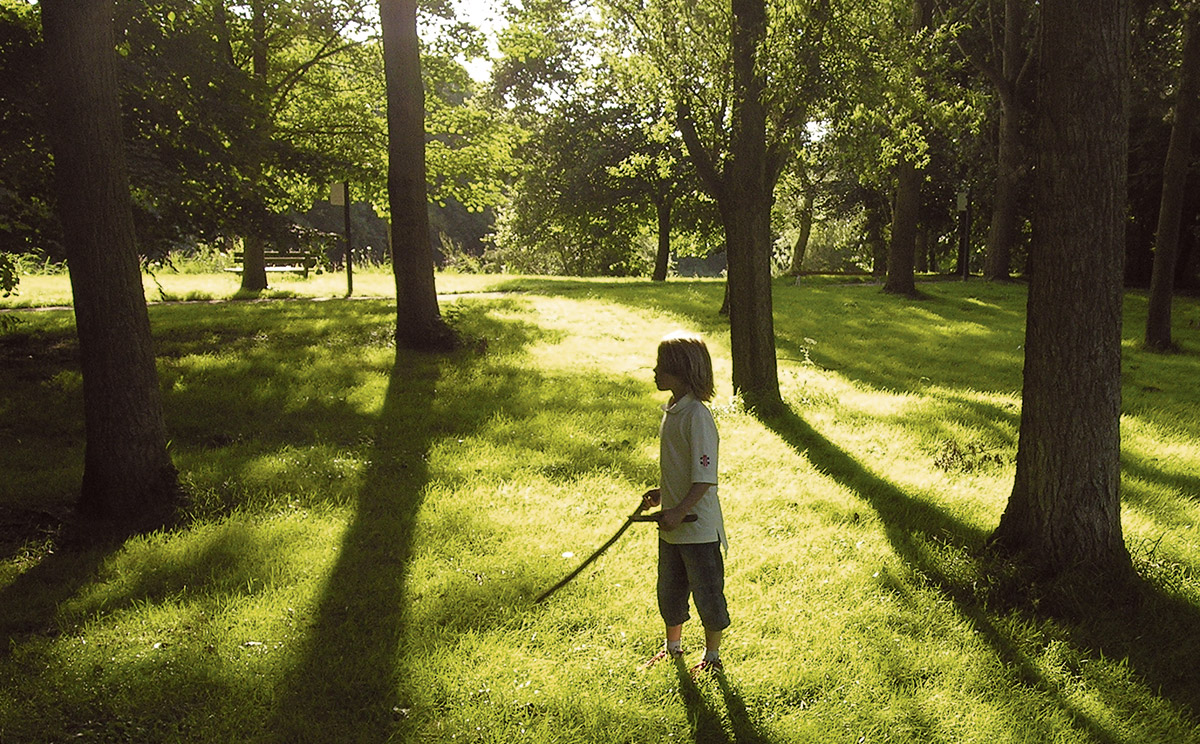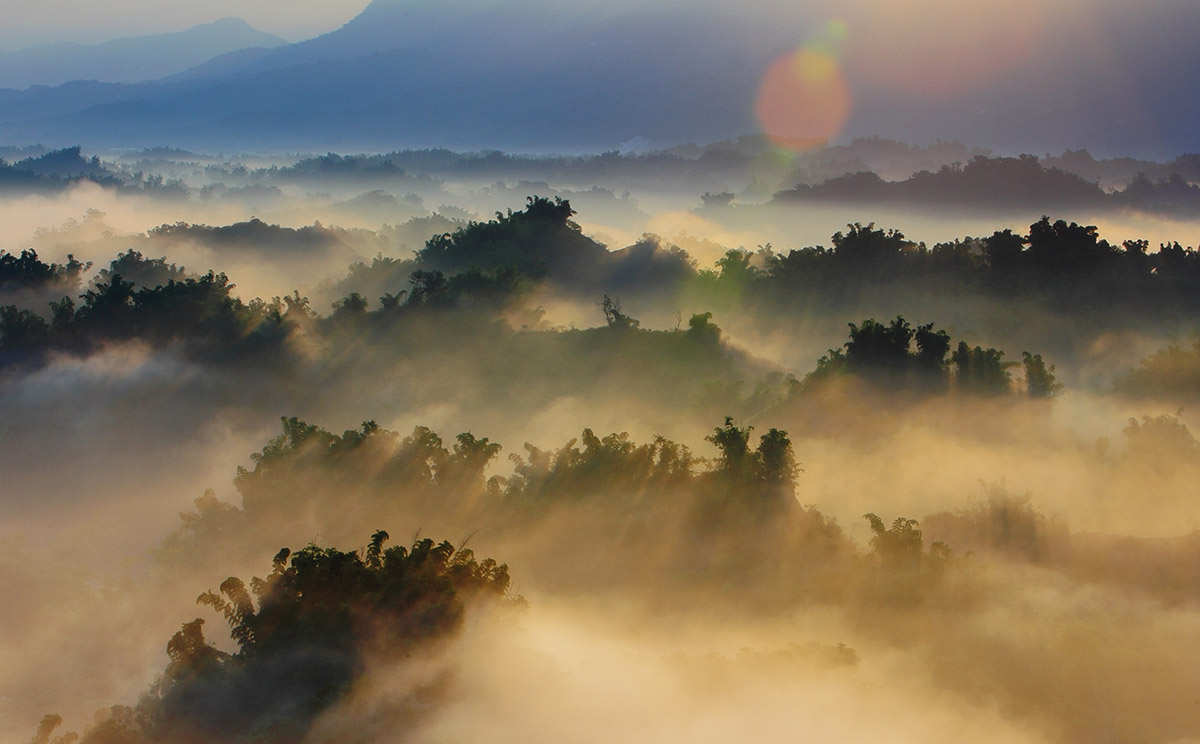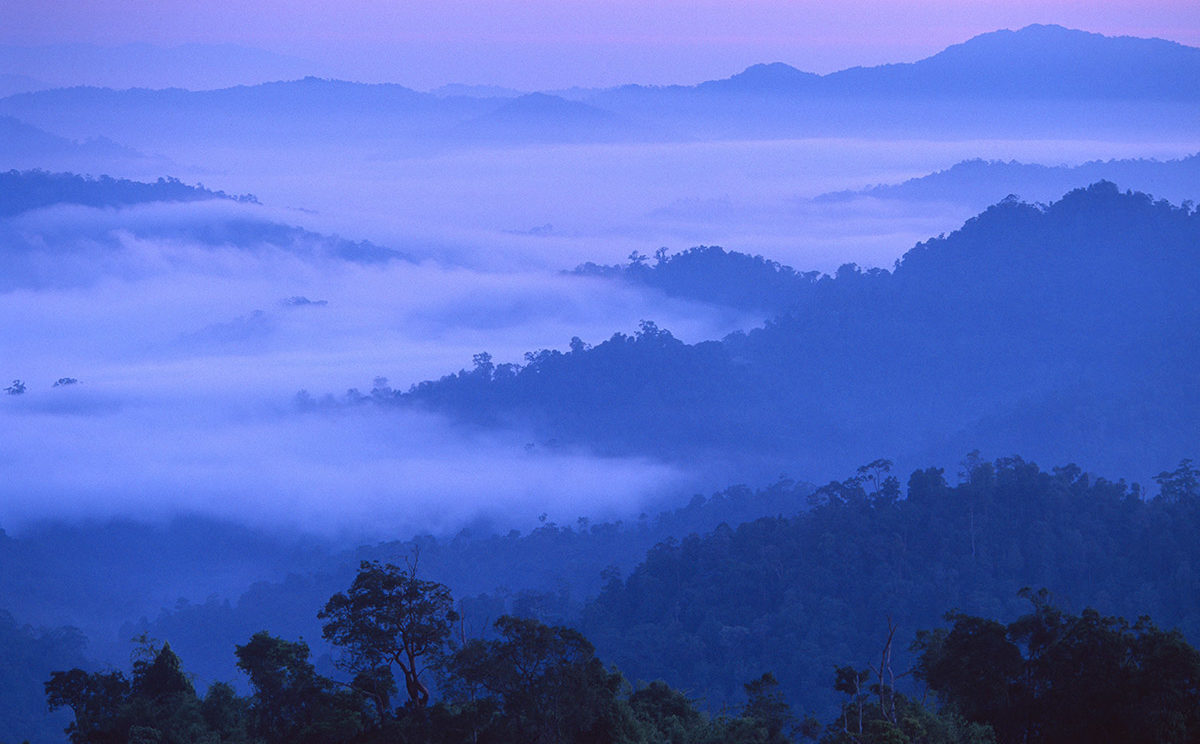An introduction to Gaia
‘Thinking of life as something separate from Earth is wrong.’
Tim Flannery [1]
‘We are failing to recognize the true value of the forest as a self-regulating sub-system that keeps the climate of the region, and to some extent the Earth, comfortable for life. Without the trees there is no rain, and without the rain there are no trees. … By letting the forest grow and sustain itself we shall have acknowledged our debt to the rest of life on Earth.’
James Lovelock [2]
Forests are essential organs of the planet. Trees do not exist to satisfy human needs but to be part of complex ecosystems and the overall metabolism of the planet as a whole.
In school we have been told that Earth is merely a ball of rock, moistened by the oceans and surrounded by a thin film of air. Popular science magazines keep telling us that the spark of life found a niche in archaic times, and began to develop into the multitude of life forms we know today – in a succession of myriads of evolutionary steps, and all by accident, supposedly. We falsely learnt that ‘life finds favourable niches’ and then ‘adapts to the given conditions’. This is only one side of the coin, and it presents a view of life as fragile (and one that subconsciously keeps us attached to fear). The Gaia hypothesis breaks with these paradigms and shows that life itself helps to shape its environment, and evolution favours species that influence their surroundings in a way that helps their offspring to flourish.
What slowly comes to consciousness is the importance of interconnectedness of all things. The first photo of a full view of planet Earth from outer space (the ‘blue marble’, taken on December 7, 1972, from Apollo 17, see image above) had a huge impact on the collective psyche of humankind, and prepared the way for new ways of thinking. In 1973, the British scientist James Lovelock, who had been working on the NASA Mars program for years, published his first paper on the Gaia hypothesis, outlining planet Earth as a complex superorganism. In the four decades since, ecology and Earth system sciences have made noteworthy progress. Here is an introduction to what really matters.
Gaia is not just a synonym for the biosphere. Gaia is the entirety of the material Earth and all living organisms on it (the ‘ecosphere‘), comprising a system capable of self-regulating the temperature and the chemical composition of the planetary surface. To sustain comfortable conditions for life the self-regulation of the system requires active processes of automatic feedback that use energy supplied by sunlight. [3]
One of the first insights that pointed to the existence of Gaia is that the Earth has maintained an average surface temperature of about 14°C since life appeared 3.8 billion years ago – despite the fact that the sun’s energy output has increased during this time by 25 per cent. And with other parameters (e.g. astronomical, geological, chemical) constantly changing too, keeping the temperatures stable is not an easy task. Amidst the vast range of temperatures possible in the physical world (from total zero to millions of degrees), the window suitable for biological life is extremely narrow: 0° to 50°C. Life has other requirements too, e.g. a pH level between 3 and 9, and, for marine life, a salt content not higher than 6 per cent. The fact that the ‘conditions in the Earth’s environment do generally meet the narrow constraints for cell survival’, says Lovelock, ‘is the strongest evidence for Gaia, the system of life and its environment.’ [4]
The system is ever-changing. No conditions are constant but continually evolve in synchrony with the changing needs of the living species. Life and its environment are closely coupled, and evolution concerns Gaia as a whole not the organisms or the environment separately.
Gaia is the largest manifestation of life that we know. It differs from other living organisms in the way a human being differs from the body’s population of living cells. When large numbers of living entities combine to make up a complex, interactive system that is more than the sum of its parts it is called a ‘superorganism’. Ecosystems, ant colonies, human societies – and Gaia – are superorganisms.
Life occupies almost all regions of the planet. Life is abundant – and has to be! There is no such thing as partial occupation; if life is to sustain itself on a planet it has to be strong in numbers and diversity. Thus, Gaia has three domains: the Earth’s crustal rock, the atmosphere and the oceans. In all of these, life interacts with matter and changes its composition.
The oceans
Without water there would be no life – and without life there would be no water. Only life enabled the Earth to hold on to its oceans. Without life, Earth would be as waterless as our planetary neighbours, Venus and Mars. They too had liquid water once. When the planets where young, the outpourings of volcanic activity caused chemical reactions with water, engaging the highly reactive oxygen and dismissing the hydrogen atoms.* These rose in the sea and through the atmosphere and, being the lightest atom in the periodic table, left the gravitational field of the planet for good. In one or two billion years Earth, like Venus and Mars, would have lost her water and irreversibly become a dead planet.
* CO2 from volcanic gases was reacting with volcanic basalt rock in the presence of water, forming the carbonates of the elements sodium, potassium, calcium, magnesium, and iron.
But in a narrow time window, all parameters were right for a beginning that was still tough but possible: life sparked on Earth and changed its course of evolution. Gaia began to show. Two strands of bacteria appeared that were able to bind Earth’s hydrogen: one kind was able to gain energy by making hydrogen sulphide near the sea floor;* another kind began photosynthesis,** thereby releasing oxygen from its bond with carbon, making possible the recreation of new H2O atoms.*** Earth’s water could be saved. [5]
* e.g. Archaeoglobus fulgidus; compare Wikipedia: Sulfate-reducing bacteria
** Still today, cyanobacteria ‘contribute significantly to global ecology and the oxygen cycle’ (Wikipedia: Cyanobacteria).
*** H2O is too heavy for a mass migration into space. And water tends to freeze out in the upper layers of the atmosphere and fall back as ice crystals.
Next, it had to be cleaned. The early oceans were a toxic brew, containing high concentrations of metals like iron, chromium, copper, lead and zinc, as well as carbon and other elements. Microorganisms began to speed up their metabolism by using the metals as catalysts. When they died their bodies deposited minute amounts of metals on the seafloor. In the long run, this purged the oceans of their dissolved metals and created sediments with deposits of metal ore. And in a similar process, mineral oil and gas reserves were created by microorganisms. [6]
Due to their microflora, the oceans are the largest depository of CO2. In Earth’s history they helped the global climate to cool from its volcanic past to moderate levels which make biodiversity possible. Furthermore, surface water evaporates from the oceans and forms clouds that bring rain to the continents, making possible life on land.
Furthermore, oceans, snow cover, ice sheets and clouds as well as forests and plant cover have different albedo (reflection) levels and provide Gaia with powerful feedback systems for the control of global temperature. White surfaces like snow and ice have a high albedo, reflecting 80-90 per cent of solar energy back into space, thus cooling the planet. Water has a low albedo and reflects only 5-10 per cent. The dark conifers of the boreal forests in North America and Siberia have a particularly low albedo which helps them to warm up quicker at the return of the sunlight, thus bringing forward the coming of spring to these regions. Trees, independent of their geographical location, can self-regulate the internal temperature of their leaves close to 21°C which is optimal for photosynthesis. The interior of a spruce needle on a hot summer’s day can be 40°C cooler than a dead surface of the same colour. [7]
The atmosphere
Did you know that 99 per cent of the gases of the atmosphere are the products of living organisms? (The remaining one per cent being the chemically inert noble gases, helium, neon, argon, krypton, and xenon.) The rather inactive nitrogen (78 per cent of the air) comes entirely from organisms, and so do oxygen, methane, and carbon dioxide which are in rapid exchange with the living world. The elements of the air have only ‘recently existed as part of the solids and liquids of living cells.’ [8]
The air has grown in composition so that it protects the living Earth from harmful influences and sustains a favourable climate. Just like the outer bark of a tree which protects the living tissues beneath. For example, the ozone layer captures 97-99 per cent of all ultraviolet radiation from outer space which is believed to be harmful to life.
On our living planet, the air comprises a beneficial matrix for all life on land, a medium through which life forms can find nourishment and also release their waste products, which – that is the magic of Gaia’s sustainability management! – are food for other species.
Carbon and nitrogen are essential building blocks of life, and they are readily available everywhere through the mediation of the air. On a lifeless planet, all nitrogen would end up dissolved as nitrates in the oceans, but living organisms keep this element in flux, and in the atmosphere (see The metabolism of the Earth, below). And the atmospheric CO2 level on a lifeless planet would rise above 1 per cent and bring the surface temperature close to that of boiling water. [9]
Free oxygen was very rare when the Earth was young. It was photosynthesizing bacteria, and later their sucessors, the plants, that brought up atmospheric oxygen from next to zero to the present level of 21 per cent. (Today, the Amazon rainforest produces about 20 per cent of the world’s oxygen). The blue of the sky, and the fact that Earth from outer space appears as a beautiful blue marble, is due to oxygen.
The atmosphere is a dynamic but delicate, thin layer ‘constantly being repaired and made whole by life itself.’ [10]
The rocks
The rocks are part of Gaia as much as the shell is part of a snail. The mineral world provides foundation, protection and nutrition for biological life. What has been overlooked for long is that in return, life over the 3.8 billion years of its presence has profoundly changed the rocks too.
Microorganisms greatly increase rock weathering. The breaking down of basalt rock, for example, happens a thousand times faster with the help of microorganisms than in sterile rock. [11] Wind and rain take the minerals to the rivers, lakes and oceans where they enter the active metabolism of Gaia. We are used to think of the transformation of the rocks of Earth’s crust as the result of volcanoes and other geological forces, but 75 per cent of the energy used to transform surface rocks is provided by living things such as plants, lichens and, foremostly, bacteria. They reach deep into the strata, leaching and breaking down the rock with the acids they discard. They’re microscopic work on the stone structures is three times greater in effect than that of all the world’s volcanoes combined. [12]
Thus microorganisms create soil, one of the true powerhouses of life.
Limestone and chalk rocks (like the White Cliffs of Dover in Kent) are organic, originating from marine life. Helping to create carbon sinks is one of the ways in which living organisms play a huge part in the planet’s great carbon cycle (see below).
The metabolism of the Earth
The main organs of the planetary metabolism are the oceans, the atmosphere and the crustal rocks. They are closely coupled and in their exchange of matter and energy they facilitate Gaia’s means to regulate:
• global temperatures, weather and climate
• the salt levels of the oceans
• the oxygen content of the atmosphere
• the reduction potential, especially of the atmospheric gases
• the electricity of the air
• the acidity of air, water and soil
• the availabilty of water on the continents
• the dispersal of mineral nutrients
• the strength of cosmic radiation.
None of these parameters is fixed, each one can vary (and has changed during Earth’s history) and thereby tweak other parameters with which it is interconnected. An essential task of the survival mechanisms of a superorganism like a planet is temperature control because, like the human body, a planet has an ideal working temperature, Earth’s being about 14°C.* Gaia has kept this average temperature reliable since life began 3.8 billion years ago…
* For life on land the optimum average temperature is around 23° C, for that’s the temperature at which plants flourish. The optimum for the oceans is 10° C or less, for at such degrees the surface waters can mix with bottom waters through convection, bringing nutrients to the surface and oxygen and CO2 to lower strata.
…against many odds! To fathom how delicately balanced the parameters are we shall look at the elements of the atmosphere. In the atmosphere of a dead planet, all possible chemical reactions among the gases have taken place. In chemical equilibrium, the air is like exhaust fumes, a mixture from which no more energy could be gained. On the other hand, our living planet is, in chemical terms, at a distinct disequilibrium, an unlikely, improbable cocktail of reactive and reducing gases coexisting in a highly reactive mix. There is no way that under the bombardement of ultraviolet light from the sun free oxygen would not react with methane and anything else that comes its way. The continuous coexistence of these gases can only occur because living organisms replenish them all the time. Without life, the elements of the Earth’s surface would follow their course of entropy (see below) and the planet would turn to a barren steady state, hot, waterless and inhospitable. [13]
This explains why astronomical spectroscopy can tell us if far-away planets are dead or possibly alive. ‘The atmosphere is the face of the planet, and it tells, just as do our faces, its state of health and even if it is alive or dead.’ (James Lovelock) [14]
Another crucial aspect of planetary housekeeping is salinity control of the seas. If the salt content would rise by a third it would destroy the cell membranes of almost all living organisms. The concentration increases because water that evaporates from the surface (without salt) is replenished by the influx from rivers which continuously bring dissolved salts from rock weathering on the continents. For a long time scientists did not understand why the seas do not grow ever saltier. We know now that the influx of sodium, chlorine and other salts is almost completely offset by effects of the continental drift.* The fact that such different forces as the overall water turnover of the world’s rivers and the plate tectonics of the Earth are balanced with each other can be seen as further evidence for Gaia.** The salinity too has stayed at levels benevolent for life for billions of years.
* Salts are either deposited in sediment formation or removed over hydrothermal vents at the mid-ocean ridges. This chemical recycling of the ocean waters takes between ten and hundred million years. [15]
** Gaia has a safety plan to capture excess salinity: remaining salts are removed from the oceans by the transfer of water to evaporite lagoons where they crystallize. These layers of salt are covered with mats of specialized bacterial communities which coat the salt crystals with a water-repellent varnish, thus preventing re-solution of the salts which then get deposited for good. [16]
Carbon
Carbon atoms are the chemical basis for all known life. Trees are carbon structures, with 50 per cent of dried wood being pure carbon, and 18.5 per cent of the weight of the human body is carbon.
Carbon is created when in the core of a star three helium nuclei are fused into carbon. But in order for the carbon (and other elements) to become available for biological life this star must die in a supernova explosion and scatter its elements into space as dust. This dust becomes part of the material which later forms second or third-generation star systems (with planets made up of such dust).
Carbon dioxide is the key metabolic gas in the Earth system. It is also one of the potent ‘greenhouse gases’ when it is located in the atmosphere, and worldwide it affects climate, plant growth and oxygen production.
The carbon cycle
When the Earth was young gigantic amounts of carbon entered the atmosphere through the activity of volcanoes and the weathering of volcanic rock. The oceans absorb a large part of atmospheric carbon dioxide, and rivers bring more carbon compounds (from the breakdown of rocks) from the landmasses. The continuous influx of carbon is balanced by marine organisms such as plankton, algae and corals which deposit huge amounts of calcium carbonate on the ocean floors where they form layers which eventually get compressed into sedimentary rock (limestone).
On land, higher plants practicing photosynthesis filter vast amounts of CO2 from the air, split the molecules, release the oxygen and use the carbon to create sugar compounds to transfer and store the captured solar energy. They use it for their own physical bodies and when they die share it with other life forms. Hence life itself acts as a ‘carbon sink’ in many ways. It has been estimated that between 0.5 and one trillion tonnes of (pure) carbon are presently bound in living beings (while the soils hold three times that). [17] Each year green plants convert around one hundred billion tonnes of atmospheric carbon into living plant tissue. [18]
But a planet populated by plants alone could not live long either. In a few million years plants would reduce atmospheric CO2 to dangerously low levels and, by eating the blanket that keeps the Earth warm, turn the planet to a frozen state. [19] That’s where us humans come in, and the animals, and even more so the ‘fermenters’, the scavengers of the bacterial world who live on the excreted matter or dead bodies of the ‘primary producers’. All of us scavengers use organic matter produced by plants (and other primary producers such as algae and bacteria) and release some of the carbon again into the atmosphere.* Thus the carbon cycle is complete (albeit much more complex in truth).
* Most noteworthy as methane, a carbon compound (CH4) which is 34 times more effective as a greenhouse gas than CO2.
Nitrogen
Nitrogen is a key element in proteins and DNA and therefore essential for life. Like all chemical elements in this chapter it is star-born and has been with Earth since the very beginning. Nitrogen is one of the seven most abundant elements in our galaxy and solar system. It forms almost 80 per cent of the atmosphere of the Earth, and about three per cent of the weight of the human body.
Unlike carbon and oxygen it is chemically rather inert, it takes a lightning flash to combine nitrogen with oxygen, for example. Nitric acid resulting from such events will fall with the rain but elemental nitrogen cannot be used directly by plants or animals. First it must be captured and converted to biological compounds by nitrogen-fixing microorganisms. These little helpers guarantee a constant supply of nitrogen to all plants and animals. Tree roots and their fungi, for example, will then assimilate the nitrates prepared by bacteria. Other microorganisms work at the other end of the scale where they decompose dead organic matter and release nitrogen back into the atmosphere.
It is living beings which have released all the nitrogen of the air, and which keep the nitrogen cycle in motion. The total nitrogen flux of Earth’s metabolism is about 500 megatonnes a year. [20]
From Gaia’s perspective, nitrogen needs to be kept in the air for various reasons. Firstly, it sustains most of the atmospheric pressure which is nothing less than a base parameter for all chemical and physical events on Earth. Secondly, it serves as a chemical diluent: without it the levels of other gases would rise too much, greenhouse gases would heat up the planet, and oxygen would set the air aflame. [21]
Oxygen
Oxygen is the third-most abundant element in the universe (after hydrogen and helium), and the most abundant element by mass in the Earth’s crust, making up almost half of the crust’s mass. Despite all that it is not readily available in the atmosphere of a dead planet, because of its fierce reactivity with other atoms. Accordingly, oxygen was only a trace element in the atmosphere during the early eons of Earth’s existence. Over three billion years ago, cyanobacteria began to produce free oxygen through photosynthesis, but their waste product (the oxygen) could not offset the oxygen absorption by tectonic and volcanic activity. Only gradually could the tireless activity of microorganisms gain prevalence and reach a net incremental increase of oxygen.*
* Due to the photosynthesizers but also to those microorganisms that helped to bury carbon compounds in the sea floor. Carbon that would otherwise engage to free oxygen to form CO2.
When oxygen finally began to accumulate in the air a whole new chapter of Earth history began. First this restless element oxidized methane which had previously been dominating the atmosphere. Oxygen made nutrients available that were scarce before (through increased weathering of surface rocks as well as through oxidation of nitrogen to nitrate) and hence triggered the evolution of photosynthesizers into ever more complex land plants. These in turn created more and more oxygen – most noteworthy are the forests of the Carbon age, see Wiki. When the air had at least 10 per cent of oxygen, larger animals could evolve. The present oxygen level of almost 21 per cent of the volume of the air makes the sky blue and clear, and the energy it provides allows us to move and birds to fly.
But all the while, oxygen is a continuous hazard. Oxidative metabolism (the extraction of energy from food through its reaction with oxygen) as practiced by our bodies exposes the cells to the toxic effects of free radicals. Like nuclear radiation, they can lead to mutations (and possibly cancer). From our distant bacterial ancestors we inherited a number of tactics (antioxidants*) to deal with these dangerous substances. But the price is high, the stress on the cells is believed to be a key factor of ageing. [22] Trees do well in expelling this element as soon as it occurs, they do not move about but they can live much longer than us.
* For examle, our bodies counteract the malign hydroxyl radical with tocopherol (vitamin E), hydrogen peroxide with enzymes such as catalase, and superoxide with superoxide dismutase. [22]
Trees too have an issue with oxygen though: fire. Among the elements, oxygen is particularly correlated with flammability. Below 15 per cent oxygen in the air, nothing will burn. Every one per cent rise in oxygen increases the chance of ignition by about 70 per cent. At 25 per cent, combustion is instant and so ferocious that even damp wood of a tropical rain forests would ignite.* Gaia has kept the level close to 21 per cent constant for hundreds of millions of years. [23] The existence of charcoal layers in the geological record show for how long Earth’s atmosphere has had at least 15 per cent of oxygen. On the other hand, fossils from ancient forests prove that the level never reached 25 per cent. [24] However, it can do locally when on hot, dry days in the subtropics the shrubland leaves photosynthesize intensively in the sun and release oxygen that accumulates in the windless air close around them. Then hot air can self-ignite (particularly if it is rich in aetheric oils e.g. around eucalyptus trees). [25]
* Those who doubt may look to nuclear submarines on board of which the oxygen level of the air is not permitted to reach even 22% because of the greatly increased risk of fire it would bring. [25]
But many bushfires in the Mediterranean, and probably Siberia, are started by desperate fire fighters who would not have a job for the summer otherwise. In such countries, a new payment system for volunteer fire fighters needs to be installed urgently and swiftly!
Sulphur
Sulphur is an essential element for life, being present in various biochemical processes, in vitamins, antioxidants, and proteins. It occurs naturally and abundantly in its pure form or as sulfide and sulfate minerals.
The continents continuously lose sulphur because rivers annually carry millions of tonnes of it to the sea. Marine life has no shortage of this nutrient but Gaia had to develop mechanisms to ensure the return of sufficient sulphur amounts to the landmasses. Most algae emit sulphur compounds such as DMS (dimethyl sulfide). Its oxidation in the air above the sea forms droplets of sulphuric acid which act as condensation nuclei for cloud formation. This extra cloud formation has a global cooling effect (because of the high albedo of clouds) and with the rain it brings precious sulphates to feed the plants on land. It also has a multiple positive feedback on algal growth: clouds locally shade the water (algae prefer cool waters), they increase wind velocity which stirs the depleted surface waters and mixes them with the deeper nutrient-rich strata. Apart from this immediate reward for the algae (which supposedly led to the evolution of this system) the sulphates on land increase the rate of rock weathering and therefore plant growth – plants which will make more nutrients available which in time will also reach the algae. Thus the sulphur cycle is regarded as mutually beneficial for land- and sea-based ecosystems. [26]
Rain naturally contains a number of acids,* but they are so highly diluted that they are benign to life. The balance was only tipped when the industrial revolution began to burn vast amounts of fossil fuels – coal and oil both contain about one per cent of sulphur. [27]In the 1980s, before CO2 was made the new scapegoat for all problems of humankind, ‘acid rain’ was the big culprit in the environmental discussion, but it turned out that the problem of acidification is not due to a particular acid but to an over-increase in free positive hydrogen atoms. Research projects by the German forestry commission tried to prove tree damage by sulphuric rain and failed.** [28]
* The acids occurring naturally (in minute amounts) in the rain are carbonic acid, formic, nitric, sulphuric, methanesulphonic, and hydrochloric acids.
** With an outdoor experiment in the Hoeglwald near Augsburg (Bavaria) a number of German universities and established institutes tried to prove the supposedly fatal effects of ‘acid rain’ – and failed. Artificial sprinkling with dilute sulphuric acid and an anticipated acid input of 120 years did not create any visible damage to the exposed conifers over many years. Although an already heavily acidic soil with an exhausted buffering capability had been consciously chosen, not the slightest additional acidification could be achieved in the living trees, only higher acid levels in the dead needle cover on the ground, and resulting damages in ground plants (e.g. common wood sorrel). After repeatedly being given extra time, this experiment was stopped after seven years of ‘unsuccessful’ acid sprinkling. [28]
Phosphorus
Phosphorus is required in the structural framework of DNA and RNA, and also for the energy transport in photosynthesis. The human body contains about 700 grams of this element, up to 1.5 grams are expelled daily (mostly with the urine) and need replenishing through food. Phosphorus is one of the essential plant nutrients and therefore used to sustain the human population: surface-mined from phophate rock it is used to produce phosphate fertilizers.* The phosphate rocks have been created millions of years ago by marine microorganisms and now their work sustains the entire biosphere. [29]
* In 2011, 190 million tons of phosphate were mined globally (U.S. Geological Survey).
Nowadays a part of such agricultural products is washed out into the sea (and some lakes) where it frequently causes algal blooms or jellyfish plagues near the rivermouths and coasts. But before human intervention, nature had to find other ways of supporting marine life with this key nutrient. This reveals one of the surprising effects of the fire ecology of the forests: it frees up phosphorus which the wind blows away from the flames. A part of the mobilized phosphorus finds its way down the rivers to the sea. Thus forest fires can boost algal growth and thereby increase oxygen production. Wildfires (true, not man-made!) must be redefined in the context of Gaia’s mechanisms for the regulation of atmospheric oxygen. [30]
Calcium
Although calcium is essential for life it is highly toxic in the free ionic state. Already in the early oceans, bacteria and microscopic plants (algae) began to convert the dangerous calcium ions into insoluble calcium carbonate to make shells for themselves. This did not only reduce the calcium levels in their cells but also increased protection of their organism immensely. Later, higher animals (including us) adopted the same trick of keeping most calcium out of cell metabolism by using it for strong bones and teeth. [31]
Life
This brief look into the planetary metabolism indicates the sheer volume and power that life exerts on its ‘environment’. It brings home that these two cannot be seen seperately, and also that a living planet needs to be inhabited full-scale, there is no such thing as part-occupation of a planet. And one aspect of completeness is biodiversity!
Looking into the seven chemical elements described above shows how the very ingredients of biological life can also be potent poisons if they occur in the wrong amount or setup. As Paracelsus said: ‘The dose is the poison.‘ Life happens on razor’s edge.
The second law of thermodynamics says that when one form of energy is converted into another, a certain proportion always escapes as heat. In other words, all natural processes logically move towards thermodynamic equilibrium, until no more energy can be gained anywhere. This steady state is called the state of maximum entropy (i.e. the degree of order is zero). Everything in the universe is increasing in entropy, i.e. it increases in disorder. Living organisms require food as a constant input of energy to offset this physical law and maintain their high inner levels of organisation (i.e. their low entropy).
But in the world of physics, biological life should not have occurred in the first place. Life continuously reverses the increasing entropy of all existence by organizing ever-more complex organisms and super-organisms, gathering experience and storing information. Metaphorically, says Lovelock, the ‘most amazing property and characteristic of life is its ability to move upstream against the flow of time. Life is the paradoxical contradiction to the second law of thermodynamics … Even more remarkable, this unstable, this apparently illegal, state of life has persisted on the Earth for a sizable fraction of the age of the universe itself.’ [32] For over three billion years, Gaia has been increasing its degree of order and complexity. Earth truely is the planet that breaks all the rules.
Life is the antedote to the mortality of the universe.
The evolution of forests
When life spread over the landmasses it became essential to ensure a sufficient water supply at any distance from the ocean. Life on land required a method to transport moisture inland from the ocean. Rain clouds, of course, are a good starting point, but these have rained off their water cargo after a maximum distance of 600km. How could life venture further inland? The solution was a biological one: the evolution of forest – a contiguous surface cover consisting of tall plants (trees) closely interacting with all other organisms to let grow a rich ecological community. Forests are responsible both for the initial accumulation of water on continents in the geological past and for the stable maintenance of the accumulated water stores ever since.
How well this works can still be observed in the Amazon Basin. The tropical rainforest absorbs three quarters of the sunlight. Its gigantic energy household creates wood and steam – through the process called evapotranspiration the South American rainforest releases about twice as much water vapour as the neighbouring Atlantic Ocean. Trees are also able to emit certain substances that act as cloud condensation nuclei, and the new, tree-formed clouds drift inland where the water rains down again. In the entire Amazon, from east to west, the water is recycled five to six times. Forests are rain-makers. And the clouds they generate are an essential part of the global ccoling system.
This system requires intact primary forest. It does not work with plantations of flimsy little seedlings from tree nurseries. Furthermore, the coastal wooden belt of 600km must be left intact. Otherwise an entire continent can become barren and drift into desertification. Without the forest the rain will leach out the nutrients and finally wash away the soil. Much of the store of fresh water on land ‘including the water of soil, bogs, mountain glaciers and lakes’ will disappear. ‘This means that all liquid moisture accumulated on land runs to the ocean in about four years.’ [33] Compare: The impact of forests on climate
The cosmic view
A common property of life is that of a protective boundary – a membrane or a cell wall on the microscopic level, skin or bark on single organisms, the upper atmosphere on planetary level, and territorial or moral frontiers of superorganisms like an ant colony or human society. However, to live requires an exchange with the surrounding, an uptake or import of energy and an output of waste and trade products. The boundary is the organ that defines this exchange, and by doing so it defines the very nature and character of the organism.
Our materialistic culture has for too long separated the life within its boundary from its surroundings, pretending it could exist on its own. But a human being or a bear or a tree need the entire Earth to live – or what would they do floating in outer space? As much as we need the Earth so does the living Earth need its ten million species…
…and ideally none less! As ecology has only recently shown, ecosystems are the more stable the more species they contain. Biodiversity is not just luxury or a whim of nature, it is a safety measure that ensures life’s continuity.
The Earth, it seems, holds a very rare if not unique position in planetary evolution. Many people think that, given the (supposed) age of the universe and the incredible amount of stars and galaxies therein, there must be many other living planets, if only by probability and sheer strength of numbers. What they overlook is that it took at least two generations of stars to create the elements of life. All of us, trees and humans and the entire Earth, are made of stardust. Hence no biological life anywhere in the universe can be much older than Gaia. [34]
And there she is, our blue planet. For 3.8 billion years she has kept the temperature, the ph levels, the salinity and all the other parameters favourable for life. Gaia is strong. Life is so strong on Earth that neither the comet that extinguished the dinosaurs nor a possible disaster unleashed by human ignorance could fully exterminate it. We don’t have to ‘save the planet’, we cannot destroy it. But we can threaten the survival of our own species (which is what we are currently doing with full steam) and we can harm Gaia badly and throw her evolution back by millions of years.
Life is unspeakably precious. And for us Life has to be synonymous with Earth, for we don’t know of any other. Even if we’d found another living planet with one of the new super-telescopes we could not get there. That would be missing the point entirely anyway because we are a part of Earth. And only here we can do our best. Let’s get started, shall we?
It is the Earth that counts. She is more important than anyone of us. But what a joy to be part of this cosmic adventure.
Fred Hageneder, February 2014
Sources
1 Flannery 2012, p.40
2 Lovelock 2000c, p.17
3 Lovelock 2000a, p.19-20, 30
4 Lovelock 2000c, p.98
5 Lovelock 2000b, p.110; Lovelock 2000c, p.79-81
6 Flannery 2012, p.48-9
7 Lovelock 2009, p.21
8 Lovelock 2000b, p.68
9 Lovelock 2000a, p.41; Flannery 2007, p.19
10 Flannery 2012, p.46
11 Lovelock 2000c, S.111, refering to D W Schwartzman and T Volk, ‘Biotic enhancement of weathering and the habitability of Earth’, Nature, 340, 457-460, 1989
12 Flannery 2012, p.45
13 Lovelock 2000c, p.21
14 Lovelock 2000b, p.67
15 Flannery 2012, p.53; Lovelock 2000b, p.102-3
16 Lovelock 2000c, p.96, 130
17 Flannery 2007, p.28. Compare Wikipedia: Carbon cycle
18 Flannery 2012, p.42
19 Lovelock 2000b, p.73, 121
20 Lovelock 2000c, p.119
21 Lovelock 2000c, p.114
22 Lovelock 2000b, p.122; Lovelock 2000c, p.116
23 Lovelock 2000c, p.29
24 ibid., p.114
25 ibid., p.115
26 Lovelock 2000b, p.133-41; Lovelock 2000c, p.122-5. Compare Wikipedia: Sulfur cycle. Also Wikipedia: CLAW hypothesis
27 Lovelock 2000b, p.151-3
28 Kreutzer, K., 1994, ‘Folgerungen aus der Hoeglwald-Forschung’, in: AFZ 14/1994. Auch: Rothe, A., 1994, ‘Saure Beregnung und Kalkung, Auswirkungen auf Bodenchemie und Wasserqualität’, in: AFZ 14/1994.
29 Der Spiegel 37/2013, p.122-3
30 Lovelock 2000b, p.125-6
31 Lovelock 2000b, p.97-9
32 Lovelock 2000b, p.23
33 Makarieva & Gorshkov 2006; also Lovelock 2000c, p.158
34 Flannery 2012, p.42; Lovelock 2000b, p.65
Bibliography
Flannery, Tim, 2007. We Are the Weather-Makers: How We Are Changing the Climate and What It Means for Life on Earth. Harper, Toronto
Flannery, Tim, 2012. Here on Earth: A Twin Biography of the Planet and the Human Race. Penguin, London
Lovelock, James, 2000 (a). Gaia: A New Look at Life on Earth. Oxford University Press
Lovelock, James, 2000 (b). The Ages of Gaia: A Biography of our Living Earth. Oxford University Press
Lovelock, James, 2000 (c). Gaia: The Practical Science of Planetary Medicine. Gaia Books, London
Lovelock, James, 2009. The Vanishing Face of Gaia: A Final Warning. Penguin, London
Makarieva, A.M. & Gorshkov, V.G. 2006. ‘Biotic pump of atmospheric moisture as driver of the hydrological cycle on land’, Hydrology and Earth System Sciences, 3, 2621-2673.
Further reading
Schwartzman, D.W., Volk, T. (2004). ‘Does life drive disequilibrium in the biosphere?’ Scientists Debate Gaia, edited by S. H. Schneider et al., The MIT Press, 129-135.
Schwartzman, D.W., Shore, S.N., Volk, T. and McMenamin, M. (1994). ‘Self-organization of the earth’s biosphere—geochemical or geophysiological?’, Origins of Life and Evolution of the Biosphere, 24, 435-450.
Volk, T. (2009). ‘How the biosphere works’, in Gaia in Turmoil: Climate Change, Biodepletion, and Earth Ethics in an Age of Crisis (eds: E. Crist and B. Rinker), The MIT Press, 27-40.
Volk, T. (1989). ‘Rise of angiosperms as a factor in long-term climatic cooling’, Geology, 17, 107-110.
Volk, T. (2006). ‘Real concerns, false gods’. Nature, 440, 869-870. (Review of The Revenge of Gaia by James Lovelock).
